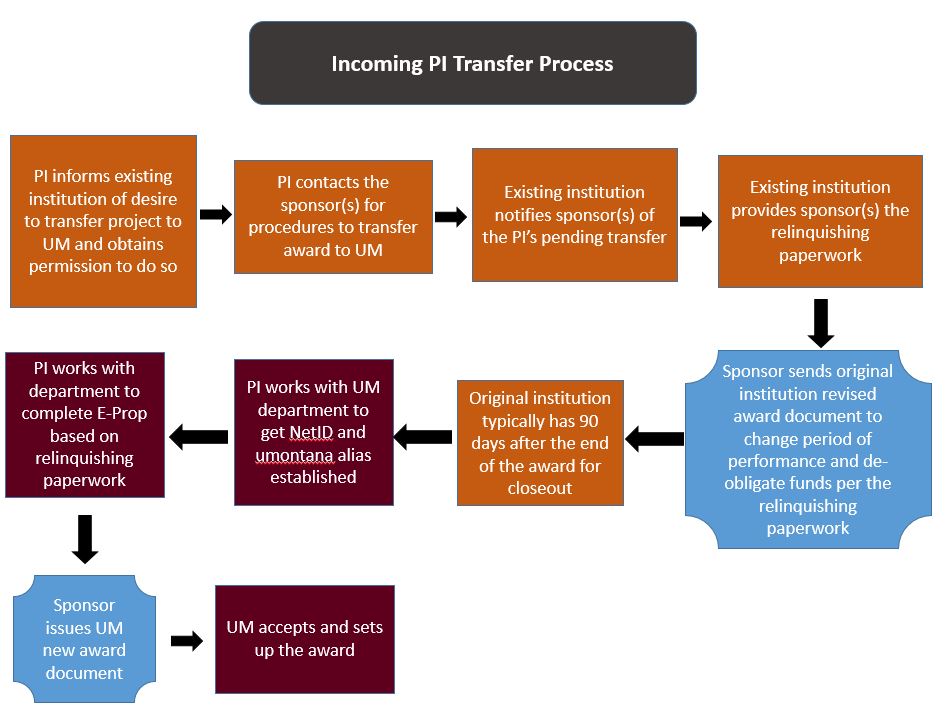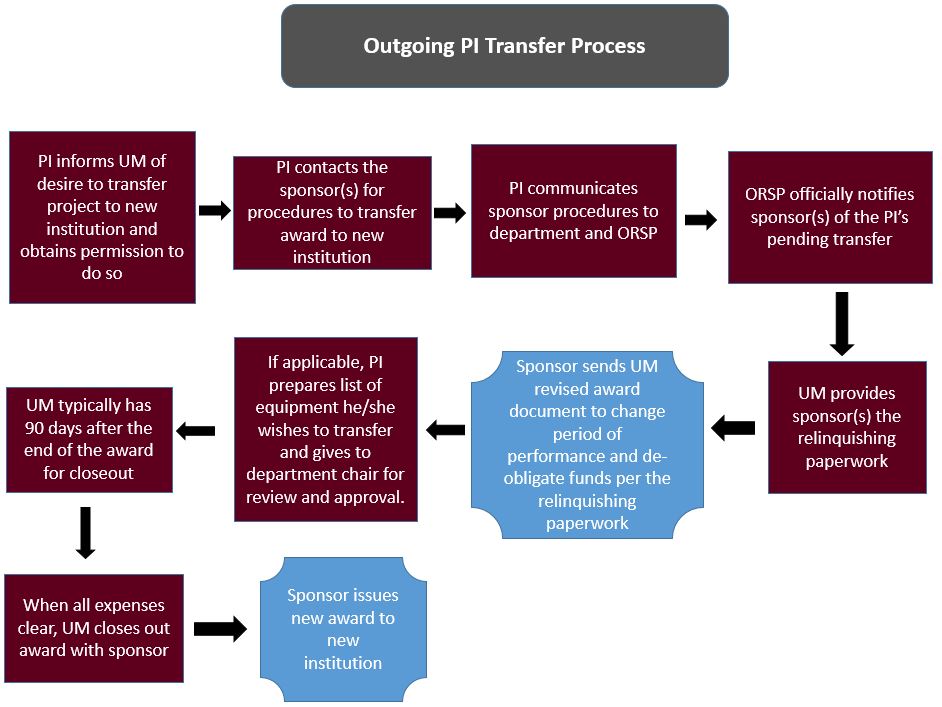PI Transfer Process
Incoming PI Transfer
High-level Overview

Once a new PI agrees to relocate to the University of Montana, the process to transfer his/her grants begins.
- The department establishes the PI in the UM IT system (NetID and umontana alias established), and sends the UM Mandatory PI Training information to the PI to complete prior to award set up.
- The department communicates to the ORSP departmentally-assigned SPS the PI’s date of arrival and projects and the projects he/she wishes to transfer to UM.
- ORSP assures the PI and department that UM will accept the award.
The PI:
- notifies his/her existing office of sponsored programs (OSP) that he/she is leaving and wishes to transfer the project to UM;
- obtains approval from the original institution and OSP to transfer awards;
- contacts the sponsor(s) for the procedures to transfer awards to UM and sends that information in writing to his/her OSP.
The original institution officially notifies the sponsor(s) of the PI’s plans and confirms that the institution is willing to transfer the award(s) to UM. Sponsors generally allow Change of Grantee Organization notices when:
- Original grantee institution agrees to relinquish an existing award
- Change of grantee institution is made to a pending award before the PI's anticipated start date at UM
Relinquishing an Existing Award
The next step is usually the relinquishment paperwork, required by the sponsor and completed by the original institution. These forms relinquish the original institution’s interests in the grant and provide an estimate of funds that will be remaining at the time of the transfer. The original institution then submits this paperwork to the sponsor.
Sponsors will send the original institution a revised award document reflecting revised project period dates, deletion of future‐year support, and de‐obligation of remaining funds based on estimated funds remaining listed on Relinquishing Statement.
The PI then informs UM of the approval of the project transfer and the balance on the relinquishing statement. The PI must complete UM's Mandatory PI Training and then work with the UM department to create the UM budget from the anticipated transfer amount, adjusting the remaining award totals for changes in salaries, fringe rates, F&A recovery, etc. The budget, budget justification, scope of work, must be attached to the E-Prop, as well as and a copy of the original solicitation and, when possible, the award to the original institution. If subawards are to be issued by UM, either back to the PI's original institution or other, this should be identified on E-Prop and a budget, budget justification, scope of work, and commitment letter will be required.
Normally, the PI and UM department will work with the sponsor's grants manager to initiate the transfer. Then the PI/department and ORSP will complete and submit according to the sponsor directions
The UM budget, budget justification, and proposal information will likely need to be entered into the sponsor's electronic system (e.g., grants.gov, Fastlane) in order for the transfer to be authorized.
A sponsor cannot transfer an existing award until the original institution formally closes out the project and institutions typically have 90 days past the end of date for close out. Thus, transfer of an award may take 5-12 months. As a result, it may be appropriate for the UM award to be set up via OPAS.
Transferring a Pending Award
If an award has not yet been made to the original institution but the PI has received the intent to fund, the program officer may handle the transfer “behind the scenes” by manually processing the award transfer. In this case, UM ORSP may be asked to complete a cover page and/or other forms to be provided to the program officer along with the budget information. Just as with any project, the PI must complete Mandatory PI Training and an E-PRop must be completed and routed for approval.
Remember that a transfer may likely take much longer than anticipated. Thus, it may be appropriate for the UM award to be set up via OPAS.
In order to avoid problems with the transfers to UM:
- Communicate early and often
- Understand the sponsor’s transfer process
- Work closely with your ORSP departmentally-assigned pre-award sponsored programs specialist
Outgoing PI Transfer
High-level Overview

Departure of a UM Principal Investigator
When a Principal Investigator (PI) informs UM of his/her intent to leave the university, sponsor guidelines must be reviewed to determine what changes may need to be made to active awards.
The following are some of the typical options:
- Transfer an active award with the lead PI to the new institution.
- Transfer an active award with the lead PI to the new institution, and subaward part of the funds back to UM if any activity is to continue here.
- Change the lead PI at UM and retain the award.
- Retain the award at UM and change the lead PI and subaward part of the funds to the new institution so the departing PI may continue work on the project there.
- Terminate the project and return unspent budget authority to the sponsor.
- If departing individual is a Co‐Investigator, the lead PI should provide guidance to the UM department and ORSP regarding how/if the departing faculty member role will continue on the project. If determined to be institutionally viable, sponsor permission will be required to issue a subaward to the new institution for the co-I's continued involvement.
Transfers may take longer than anticipated in order to coordinate with the sponsor, UM department, and new institution, so it is best to begin the process as soon as possible. A sponsor cannot transfer an existing award until the original institution formally closes out the project and institutions typically have 90 days past the end of date for close out. Thus, transfer of an award may take 5-12 months.
Some sponsors have specific forms that must be completed, while others have no formal guidelines. The departing PI should work with his/her department to provide the following information to ORSP:
- Final date of employment at UM and effective date of transfer (usually the day after final day at UM).
- Plans for transfer or necessary changes to each active award.
- Department chair approval of proposed plan for each active award.
- Most sponsors will require a brief summary to be submitted of progress to date and description of work accomplished.
- Amount of funds to be transferred. It will be necessary to stop initiating charges to the project account, as all outstanding charges must be identified prior to making the transfer request.
- Contact information for a departmental staff person or sponsored programs staff person at the new institution.
- If the PI has been in communication with a grants manager at the sponsor/agency and received recommendations or additional guidance regarding the transfer process, please forward this information to ORSP.
- ORSP will advise the departing PI of any sponsor‐specific requirements and use the information provided to prepare the transfer request, whether it be through an online system such as NSF FastLane or with a formal letter of request with supporting documentation.
Other factors to consider
- Any subawards issued off an award that the PI will be transferring to their new institution must first be terminated and closed.
- It is recommended that the department ensure all progress and technical reports on active and expired awards under the direction of the departing PI have been submitted and approved by the sponsor prior to the departure of the PI and prior to the transfer of any awards to their new institution. Submittal of any reports that were due while the award was at UM remain the responsibility of the UM department even after the PI has left.
- The ORSP post-award SPS will work with the department and PI to confirm that all expenditures have posted to the award in order to determine the amount of the award to transfer to the new institution.
Internal PI Transfers
When a PI moves from one responsible organization (dept/center) to another within UM, the Banner Grant Module programming does not allow us to change the responsible organization. Therefore, the following solution has been used since the implementation of Banner in 1999:
- The previous responsible organization gives permissions for the new responsible organization to access those index codes.
- With the recent implementation of Dynamic F&A, we are able to change the F&A code in Banner so that the new responsible organization receives the new F&A split that is negotiated with the Vice President for Research & Creative Scholarship.
- If the new organization does not have a SPABA index, that index must be set up with the VPRCS’s office before the new dynamic F&A code can be assigned by the Assistant Director of the Office of Sponsored Programs.
- If there is a delay in setting up the SPABA index, the OSP post-award specialist can make a one-time F&A adjustment from the date the PI transfer happened, after the new dynamic F&A code is assigned.
If there are justifiable extenuating circumstances, a new fund/index can be set up with the remainder of the budget from the original fund/index; however, this requires a formal exception from the Director of the Office of Sponsored Programs. This is not standard operating procedure, since there is significant movement of PIs among departments and centers at UM. This exception carries substantial administrative burden for OSP.
Equipment Transfers
When a PI leaves UM for another educational institution, he/she may wish to transfer or sell capital equipment items purchased by UM to the new employing institution. These procedures only apply when a PI wishes to sell or transfer equipment items owned by UM or the federal government to another institution where the PI will be employed after leaving University of Montana. All other sales or transfers of equipment are coordinated through UM Business Services.
The departing PI prepares a list of equipment items requesting to be transferred or sold. This listing should be prepared not less than sixty (60) days before the PI leaves UM. Each item, the listing needs to include the following information to UM Property Management: UM equipment tag number, description of the item, purchase date(s), combined cost of the item, the UM account number(s) that funded the purchase, amounts charged to each UM account number(s), and sponsor. This list must be given to the PI's chair for review and approval. The department chair should review the listing of equipment items to be transferred or sold. The department has every right to retain the non‐restricted equipment items for the department’s use on other projects. The departing faculty member is not “entitled” to this equipment. The department is responsible for ensuring correct procedures are followed. The department chair needs to sign off on the listing indicating approval of the items to be transferred or sold.
Purchased via Federal Funds
Contract
If purchased via a federal contract or a contract subject to FAR clauses, the item cannot be transferred or sold unless written approval is obtained from the sponsor/federal agency as such items are to be used only for the purposes authorized by the contract. If the project is being transfer to the new institution, the PI must generally request approval from the sponsor to transfer the equipment item. This request to the sponsor also needs to be countersigned by the Authorized Organizational Representative in ORSP.
Grant or Cooperative Agreement - Inactive
Per 2 CFR 200.439, the title to equipment acquired under a Federal award (not a contract) will typically vest with the University of Montana. If purchased via a federally funded project that is not active (i.e. the project is past the termination date), then the depreciated value must be determined via UM Property Management.
- If the depreciated value is more than $5,000, the following federal regulations (OMB Circular A‐110 restated) apply.
- When the equipment item is no longer needed for the original project or program, the item should be used for other federally‐sponsored activities in the following order of priority: (1) activities sponsored by the federal agency which funded the original project, then (2) activities sponsored by other federal agencies.
- When the equipment item is no longer needed by UM, then the item may be used for other activities as follows: UM may retain the equipment for other uses after compensating the federal government. If UM has no need for the equipment item, UM should request disposition instructions from the federal agency. UM can request transfer of the item without cost to the new institution. The federal agency is required to issue instructions within 120 days of the request.
- If the depreciated value is less than $5,000, the department chair should first consider the existing equipment needs in the department. The priorities from the federal regulations listed above should be utilized. When the item is no longer needed by UM, the item may be sold to the new employing institution.
Purchased via Non-Federal Funds
If the equipment was purchased is from a non‐federally funded project which is not active (i.e. the project is past the termination date), the department chair should
consider the existing equipment needs in the department. When the item is no longer needed by UM the item may be sold to the new employing institution.
Price Determination
The minimum sales prices need to be determined by UM Property Management for the equipment items, unless the equipment items are being transferred without cost to the new employing institution under one of the following scenarios:
- items were purchased on an active project which is being transferred to the new institution (transfer approvals vary by sponsor); or
- written approval for the equipment transfer has been received from the sponsor/federal agency.
For non‐fully depreciated items, the minimum sales price is the current depreciated value (book value). For fully depreciated items, the minimum sales price is generally 5‐10% of the original cost. Contact UM Business Services for determination of the sales price. The department can choose to charge the acquiring institution more than the minimum sales price for an item. Shipping and handling fees are to be paid by the new institution.
Items to be sold
The department completes an XXXXX Asset Recovery Form indicating the equipment items and estimated sales prices. The form and PI prepared list that was reviewed and approved by the departmental chair are routed to ORSP and UM Property Management for review and approval of the sales prices. UM Property Management will communicate with the department after reviewing the form. UM Property Management personnel process the sale of such property.
A departmental representative should be present when the equipment items are packed up to leave UM to ensure only the items on the list are shipped to the new institution. Shipping and handling fees are to be paid by the new institution. Payment from the new institution must be made within 30 days of receipt of the equipment items. Payment should be sent to the UM Property Management. The funds will then be deposited into the UM department’s account.
Items to be transferred
- The sponsor indicates approval in writing of the equipment and/or project to the new institution. This approval is sent to ORSP, and copied to UM Property Management, for the award file.
- The UM department chair prepares a confirmation memo to the department chair at the new institution detailing the items to be transferred or sold with related sales prices, and copies ORSP and UM Property Management. The memo must contain the following statement for the new institution to sign and return after receipt of the items:
“(Institution Name) acknowledges possession of the equipment items listed below and have added the items to our inventory records. We agree to provide equivalent insurance coverage as is provided to other property owned by our institution. By accepting the terms under which this equipment is sold/transferred, (Institution Name) has no further obligation to the University of Montana."
After this statement and a listing of the items, the confirmation memo should contain a signature line for the Inventory Office at the new institution to sign and send back to the UM department after receipt of the equipment items. If federal funds purchased the item, the following statement should be included in the memo: “We also agree that we will not charge the U.S. federal government or federal‐funded projects for the use of this property.” The UM department is responsible for obtaining the new institution’s signature on this memo.
Once the confirmation memo has been signed and returned from the new institution to the UM department, a copy of the signed confirmation memo should be sent to UM Property Management and copied to ORSP.
